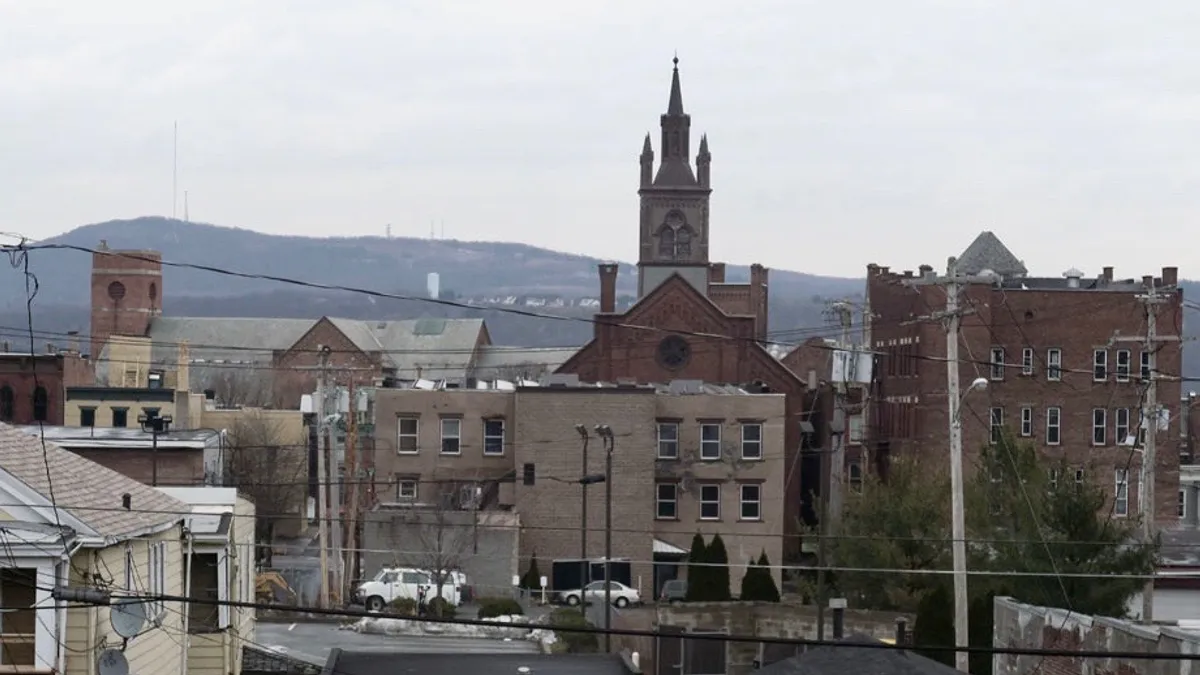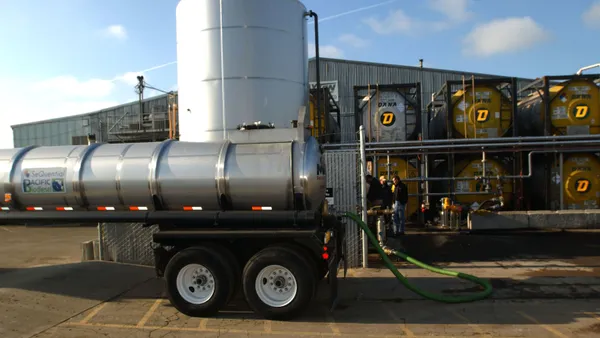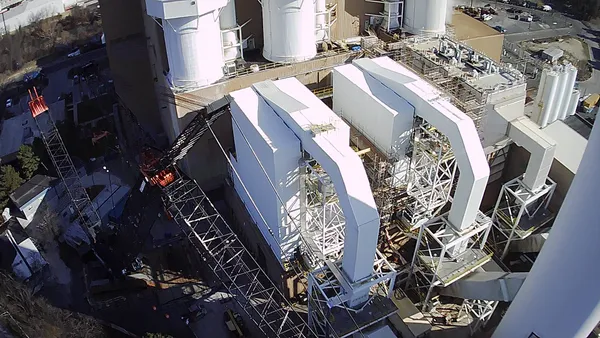UPDATE: June 22, 2020: Fallout from research finding per- and polyfluoroalkyl substances (PFAS) in soil and surface water near a Norlite Corp. plant in Cohoes, New York, resulted in the Department of Defense canceling contracts with Norlite to incinerate materials containing PFAS, the Wall Street Journal reported. And the Times-Union reported the New York Department of Environmental Conservation (DEC) told the company it may no longer incinerate PFAS-laden firefighting foam or AFFF.
That DEC order comes shortly after the state legislature banned AFFF incineration in Cohoes. That bill is still awaiting Gov. Andrew Cuomo's signature.
Dive Brief:
- Ongoing controversy over toxic chemical contamination linked to an incinerator in Cohoes, New York could spur new lawmaker action. Testing done by David Bond, a Bennington College environmental studies professor, and his students found PFAS in soil and surface water near a facility run by Norlite Corp., a company that makes a ceramic aggregate material.
- Norlite's incinerator has previously accepted PFAS-laden aqueous film-forming foam (AFFF), sparking concerns that incinerators spread the chemicals, rather than breaking them down. When the findings were presented on April 27, Bond told reporters that "far from destroying AFFF, Norlite's facility appears to be raining down a witch's brew" of PFAS onto nearby areas.
- The controversy has drawn the attention of lawmakers on a local and federal level, including Sen. Chuck Schumer (D-NY), who is seeking a federal probe by the U.S. EPA and U.S. Department of Housing and Urban Development. That push comes after a bipartisan coalition of more than 80 House of Representatives members called on the House Transportation Committee to restrict industrial discharges of PFAS, a move that could impact incinerators and landfills.
Dive Insight:
PFAS incineration has been a source of interest for some companies, with U.S. Department of Defense (DOD) contracts offering an access point. There are only nine facilities approved to burn AFFF: Norlite's Cohoes facility; Clean Harbors facilities in Arkansas, Nebraska and Texas; Veolia North America facilities in Arkansas, Illinois and Texas; and Ross Environmental Services and Heritage Environmental Services facilities in Ohio.
Norlite's parent company, Indiana-based Tradebe, contracted with DOD in November 2018 to incinerate AFFF. But the recent controversy has reignited conversations about PFAS and incineration, as the company faces pressure given that the incinerator is only 200 meters away from a public housing complex.
There are thousands of PFAS chemicals, but the Bennington study found traces of 10 associated with AFFF — including PFOS and PFOA, the two most notorious PFAS. Levels of PFOS were also twice as high downwind of the facility, indicating airborne deposition, according to Bond.
The backlash over the findings could potentially resurface challenges for incineration following a period of heightened federal attention. In 2019, Rep. Ro Khanna (D-Calif.) introduced the PFAS Waste Incineration Ban, which would require the EPA to promulgate regulations for the disposal of AFFF. The ban was later folded into a sweeping PFAS bill (H.R. 535) that passed the House but stalled in the Senate after a veto threat from President Donald Trump. A bill passed in late 2019 notably requires DOD to stop using fluorinated fire-fighting foams by October 2024, in addition to requiring those materials be burned at high enough temperatures to ensure they break down the compounds.
But the Bennington researchers said their findings show incineration might not be doing that, instead leading to contamination in nearby areas.
Some waste experts also say the process would benefit from more testing. Chris Lund, a senior vice president with Gershman, Brickner & Bratton, told Waste Dive PFAS can likely be incinerated at more than 1000°C but that no EPA protocols currently exist to verify destruction. He also expressed wariness about testing so near urban areas. "There are ones way out in the Nevada desert not near anyone where that could be tested," Lund said.
Marco Castaldi, City University of New York professor and director for the Earth Engineering Center, said PFAS can be safely incinerated under certain conditions.
"If a thermal facility operates properly at high temperature, has sufficient residence time and good mixing...the destruction removal efficiencies are normally [more than 99% effective]," Castaldi told Waste Dive, noting the "3Ts" — temperature, time, and turbulence — are key to true combustion. "If the material went through the facility and the facility was operating properly...then it is unlikely [to spread contaminants]."
Norlite did not respond to a request for comment from Waste Dive regarding the situation, but the company has stated it is not currently accepting AFFF pending EPA research. Permits from the EPA and the New York Department of Environmental Conservation affirm its activities have been within the confines of the law, according to the company.
The EPA has been under pressure to set standards for PFAS, but has yet to set maximum contaminant levels for any of the chemicals. The agency released its PFAS Action Plan update in February.
It is unclear how the fallout might impact incineration of PFAS more broadly, but scrutiny is ramping up. Environmental groups including Earthjustice sued in February to halt incineration of DOD materials containing PFAS, arguing the government failed to conduct environmental reviews of the facilities it contracts with, including Cohoes.
And after an April report from the Environmental Working Group found disposal sites owned by Waste Management and others could be leaching PFAS, House lawmakers mounted a push to institute deadlines for the EPA to determine how to regulate industrial PFAS discharges under the Clean Water Act. The lawmakers also said that should be part of future coronavirus infrastructure relief legislation.














